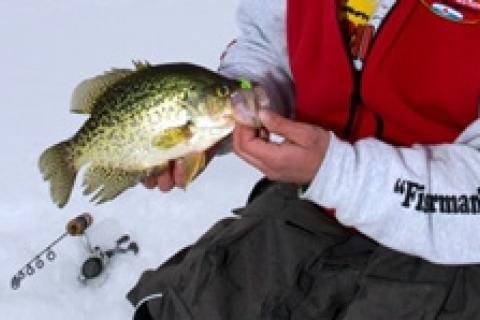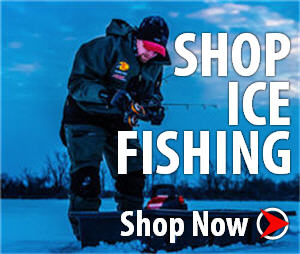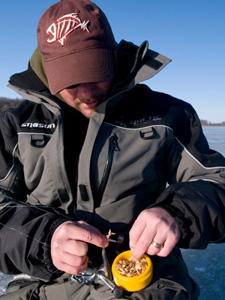
Most ice anglers have a bittersweet relationship with crappie. When you find an active school the fishing's outstanding. Yet on other days locating them can seem impossible. Try these suggestions the next time you feel you're being tested by these temperamental panfish.
 Enjoy the Hunt and Fish as a Team
Enjoy the Hunt and Fish as a Team
A lot of crappie fishing can be spent in search mode, so put yourself in the right frame of mind. Don't expect to find willing biters beneath the first hole you drill. If you systematically stalk these fish though, you'll eventually find them and the reward of landing that first slab after a lot of legwork will be worth the effort.
Teamwork will also catch you more crappies. Working as a group helps you locate the best spots faster than doing it solo, especially beneficial when tackling large expanses of water. Take time to scout areas and review maps to develop a strategy with buddies. Once on the ice, spread out and drill lots of holes to cover ground. Stay in contact with 2-way radios or meet occasionally throughout the day.
Top Ice Fishing Spots
The following fishing spots serve as good starting points for your  crappie search. In small, fertile lakes you can expect to find fish relating to deep holes or the main basin. They may also hold near healthy weeds until the vegetation dies off. In large lakes, crappie often occupy mid-depth flats or deep basin areas but will related closely to structures like points, islands, humps or at the base of drop offs. In rivers, crappie will avoid current and reside in backwater areas, like sloughs, protected shorelines, side channels or canals.
crappie search. In small, fertile lakes you can expect to find fish relating to deep holes or the main basin. They may also hold near healthy weeds until the vegetation dies off. In large lakes, crappie often occupy mid-depth flats or deep basin areas but will related closely to structures like points, islands, humps or at the base of drop offs. In rivers, crappie will avoid current and reside in backwater areas, like sloughs, protected shorelines, side channels or canals.
Work the Entire Water Column
Crappies are renowned suspenders. Astute anglers fish the entire water column and catch more fish for their efforts. Slowly swimming baits down not only helps intercept suspending fish but the presentation's more natural than dive-bombing lures. Don't discount right beneath the ice in shallow areas either. Last year I iced several crappies at dusk jigging less than a foot below my ice hole. The fish would streak in from the sides and smack the ice jig, making for productive and adrenaline-filled fishing.
Fish at Night
One of my fondest hard-water memories is an evening of incredible first-ice crappie fishing with a teenage friend. The only sounds filling the crisp, winter air were the hiss of a glowing gas lantern, our laughter, and the occasional "zip" of a reel drag. A sure-fire way to improve your winter crappie catches is fishing at night. Paper-mouths become more aggressive at twilight, pushing onto structures, like humps or points, or invading shallow areas and weed lines in search of food. Like walleye fishing, it's best to arrive early and set up in advance so you're ready when the feeding frenzy starts. Also, for around $20 or $25 you can get a compact headlamp that provides excellent hand-free illumination.
 |
| Aqua-Vu 715c Underwater Camera |
Be Sonar Savvy
Without a doubt using a portable ice sonar like the Aqua-Vu 715c Underwater Camera when targeting crappie will catch you more fish given their suspending tendencies. Monitoring the display also offers clues on the activity level of fish based on how they relate to your bait. Tweak your presentation accordingly until you crack the code to trigger bites.
The Right Jigging Combo Set-Up
A properly balanced jigging combo is critical for detecting light-biting crappie. Ultra-light line and a quality rod with either a spring bobber or a noodle tip add sensitivity and finesse when you need it. If you can't feel the weight of your bait, the set up's too heavy. Also, be prepared to drop down line strengths as fussy crappie can be line shy, especially in clear water.
 Ice Jig Details
Ice Jig Details
As crappie have good vision and the tendency to be choosy at times, presentation details make a difference. Carry an assortment of different ice jig profiles, including vertical, horizontal and 45-degree models. Also pay attention to knot positioning on horizontal jigs. The force of fighting a fish often causes the knot to slip forward on the hook eye resulting in a droopy profile. Sliding the knot back to the center keeps the bait straight.
The right color pattern can be important to tempt lock-jaw crappie, so keep your tackle box well-stocked with natural, hot, and glow painted baits. Of course, profile and hue aren't all that's required to catch fish. You'll also need to master a variety of jigging moves to make baits come alive and be successful at drawing in fish and eliciting bites.
Don't Be Afraid to Upsize to Bigger Fishing Baits
Catching crappie isn't always a finesse game. Sometimes fish will be more selective if given the time to overlook small, finesse jigs. This is when upsizing to bigger baits, such as 1.5- to 2.5-inch spoons, swimbaits and plastic baits, combined with more assertive jigging will ice you more slabs.
 |
| VMC Hot Skirt Glow Jigs |
Switching to a bigger profiled bait also helps sift through the smaller crappies and engage the bruisers. Expect crappie to hit larger lures with more gusto than small ice jigs. Good lure choices include the Rapala Jigging Shad Rap, VMC Hot Skirt Glow Jigs, LIVETARGET Golden Shiner, VMC Tumbler Spoon, and Cabela's RealImage® Jig-N-Spoon.
Ice Fishing With Live Bait Can Be Critical
The scent trail created from fresh bait is one of the most consistent ways to provoke strikes. If friends are out-fishing you and they're adding fresh bait every five minutes, this is a sign to speed up your re-baiting tempo. When fish are hot you can extend the timeframe, but when they're finicky adding new bait frequently is best, whether it's maggots, minnows, or scent-loaded soft-bait.
Try Doing Some Dead Stick Fishing
When crappie aren't interested in your jigging manoeuvres sometimes the best move is none at all. A maggot-tipped ice jig or tiny minnow rigged on a small hook dangled below a split shot are common set-line rigs. Get these baits into the strike zone and soak them. I've watched dozens of crappies on my sonar move in, then stop and stare at my bait. If you're presentation's close to perfect they'll hit the offering. Note that adding a faint jiggle after a long stand-off can also trigger bites.
- 20316 views



 Ice Jig Details
Ice Jig Details